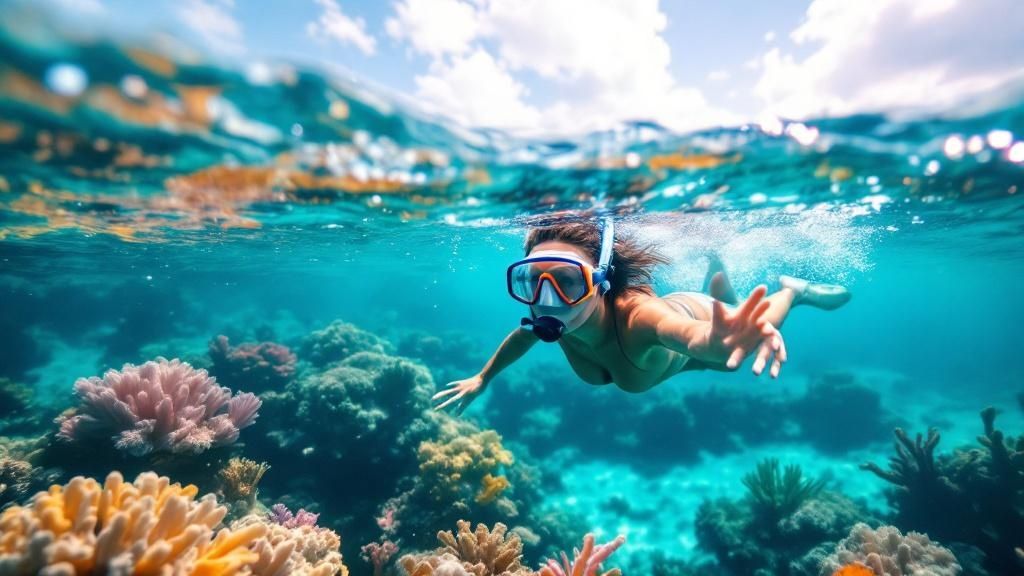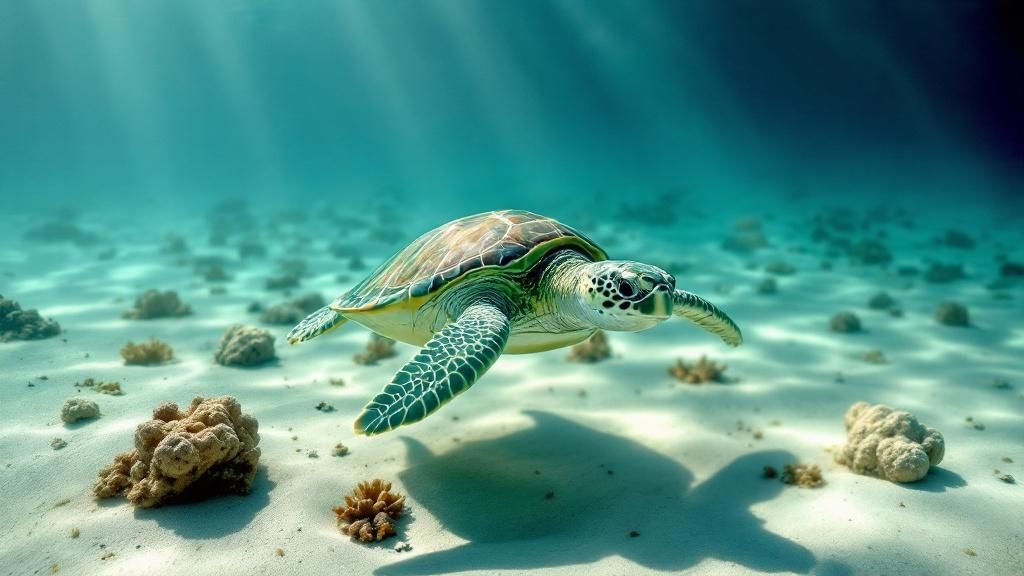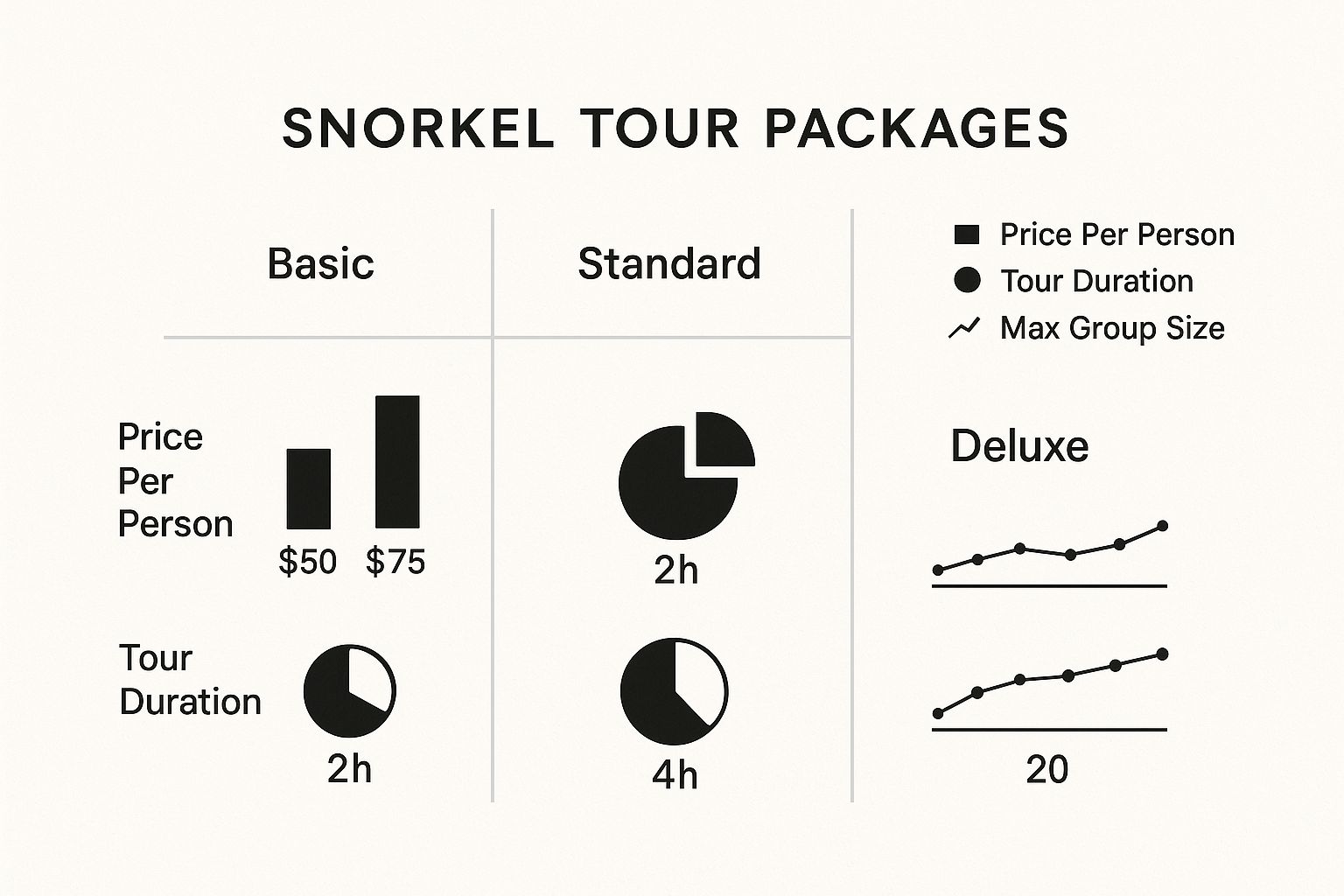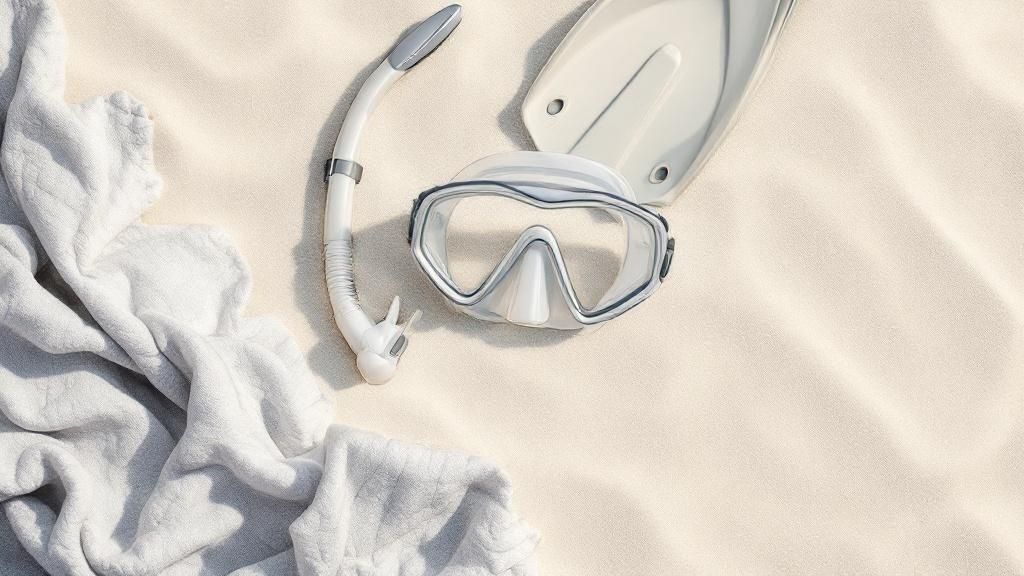Captain Cook Snorkel Tour: Experience Underwater Adventure

Why Captain Cook Tours Create Unforgettable Memories
Picture this: you're floating effortlessly in calm, crystal-clear turquoise water. Just below, a living kaleidoscope of tropical fish darts through intricate coral gardens, so close you feel like you’ve been invited into their world. This is the heart of a Captain Cook snorkel tour, an experience that goes far beyond a typical day at the beach to create memories that stick with you.
But what really sets this specific adventure in Kealakekua Bay apart? It’s not just one thing, but a perfect blend of unique geology, its protected status, and a deep sense of history.
The Science Behind the Scenery
Unlike many other coastal spots, Kealakekua Bay is naturally hugged by towering lava rock cliffs. These cliffs act as a giant, natural shield, blocking the strong ocean currents and winds that often stir up sand and sediment elsewhere. This geological shelter is the main reason the water here stays so incredibly clear, with visibility often reaching an amazing 100 feet. It’s like swimming in a huge, natural aquarium where every vibrant color of the reef is on full display.
This protected environment is also the perfect nursery for marine life. The calm, nutrient-rich waters support a thriving and complex ecosystem. The bay's official designation as a Marine Life Conservation District adds another layer of security by limiting fishing and other disruptive activities. This allows the fish populations to flourish, turning the bay into a hotspot for biodiversity. It's no wonder that over 190,000 visitors are drawn to these pristine conditions each year, making it one of Hawaii's most treasured marine destinations. For a deeper look at its popularity and impact, you can explore more insights on Kealakekua Bay tours.
A Glimpse into the Bay's Majesty
The dramatic cliffs and transparent waters create a breathtaking scene, whether you're looking down from a boat or up from below the surface.
This image perfectly captures the serene setting that makes the bay such an exceptional place for snorkeling.
More Than Just a Snorkel Spot
The combination of clear water and abundant sea life transforms your snorkeling trip into a personal encounter with the natural world. It’s the difference between watching a nature documentary on TV and actually being in it. You aren’t just looking at the reef; you are completely immersed in a vibrant, living ecosystem.
To truly get a sense of what makes these trips so special, it helps to understand the details of the Captain Cook Snorkel Tour. This unique mix of natural perfection and historical significance is what makes the experience so profound and unforgettable.
Swimming Through Centuries of Hawaiian History
Every time you dip below the surface on a Captain Cook snorkel tour, you're not just swimming—you're gliding through a living museum. The shimmering water holds a story that connects generations of Hawaiian culture with a significant moment in world history. You're not just looking at colorful coral; you're floating through a sacred space where ancient traditions and the modern world collided in a dramatic, history-shaping encounter.

This painting of Captain James Cook captures the European perspective, but the bay's real importance starts long before his arrival. This area was sacred to Native Hawaiians for centuries, serving as a central place for religious ceremonies and community gatherings.
The Bay of the Gods
Long before 1779, Kealakekua Bay was a cherished place of peace and prosperity, dedicated to the Hawaiian god Lono. It was a cultural center where chiefs held court and people came together for the Makahiki festival, a celebration of harvest and peace that lasted for months. When Captain Cook’s ships sailed into the bay during this sacred time, he was initially greeted with great honor, as some Hawaiians believed he might be a manifestation of Lono.
This period of goodwill did not last. Cultural misunderstandings and growing friction led to a tragic conflict that ended with Cook's death right here in the bay, an event that forever changed the course of Hawaiian history. Respecting this complicated past is essential for any visitor. Today's tour operators often collaborate with cultural experts to ensure the site’s sacredness is honored, blending adventure with deep respect. If you're looking into a trip, researching Big Island Captain Cook snorkeling options will help you find a tour that honors this heritage.
A Deeper Dive into the Experience
Understanding the history behind the bay changes your snorkel from a simple swim into a meaningful cultural experience. It turns out this historical depth is a huge draw for travelers. In fact, many tours now highlight this educational side, knowing that around 70% of visitors are keen to learn about the area's legacy, not just see the fish. This interest shows just how much the story enriches the adventure. You can discover more insights about the educational aspects of these tours at mantaraynightsnorkelhawaii.com. By appreciating the stories held within these waters, your visit becomes a powerful connection to Hawaiʻi's past and present.
Your Front-Row Seat to Nature's Greatest Show
Picture yourself slipping into a massive, silent amphitheater where the main event is one of nature’s most dazzling performances. That's the feeling of a Captain Cook snorkel tour. The protected waters of Kealakekua Bay are the stage, home to an incredible cast of marine life that flourishes in this special sanctuary. The bay's designation as a Marine Life Conservation District isn't just a formal title; it's a guarantee of a vibrant, healthy ecosystem.
The water clarity here is stunning, often clear for over 100 feet, which means you aren't just watching the show—you're part of it. You'll see graceful Hawaiian green sea turtles, known as honu, gliding through the water as if they've been doing it for centuries. Seeing them graze on algae along the coral formations is a common and unforgettable highlight of any visit.
The Cast of Characters
Kealakekua Bay is like a bustling underwater city with different "neighborhoods" of colorful fish, each with its own residents and daily patterns. You're almost certain to encounter schools of brilliant yellow tangs, which move together like a single, flowing golden cloud. They are the bay's most famous residents, their bright color popping against the deep blue water and dark lava rock. Another key character is the humuhumunukunukuāpuaʻa, Hawaii’s state fish, a type of triggerfish known for its unique patterns and spunky attitude.
To help you identify the amazing creatures you'll see, here's a field guide to some of the most common and spectacular species in the bay.
| Species Name | Key Features | Typical Behavior | Best Viewing Spots |
|---|---|---|---|
| Yellow Tang (Zebrasoma flavescens) | Bright, solid yellow oval-shaped body. | Often seen in large schools, grazing on algae. They are active and constantly moving. | Throughout the reef, especially in sunny, shallow areas over the coral. |
| Hawaiian Green Sea Turtle (Honu) | Large reptile with a dark, patterned shell. | Glides gracefully through the water or rests on the sandy bottom. Frequently surfaces for air. | Near coral ledges where they feed on algae, or resting in calmer, sandy patches. |
| Spinner Dolphin (Naia) | Sleek, grey body. Known for acrobatic leaps and spins. | Highly social, traveling in large pods. Most active in the early morning and late afternoon. | Often seen at the mouth of the bay or further offshore. Look for splashes on the surface. |
| Parrotfish (Uhu) | Brightly colored (blues, greens, pinks) with a beak-like mouth. | Scrapes algae off coral with its "beak," creating sand. You can often hear them crunching. | Actively feeding along the entire reef face. |
| Humuhumunukunukuāpuaʻa | Rectangular body with bold patterns and blue lines near the mouth. | Territorial and often solitary. Swims in a quirky, determined manner. | Near rocky crevices and ledges where it can hide. |
| Octopus (He'e) | Master of camouflage, can change color and texture instantly. | Shy and elusive. Prefers to hide in holes and under rocks, emerging to hunt. | A rare find! Look for them tucked into coral heads or rock piles. |
This table gives you a snapshot of the bay's biodiversity. From the ever-present reef fish to the larger, more majestic animals, every trip offers a chance to see something new and amazing.

The image above from Wikipedia shows just a sample of the incredible number of species documented in the bay. It's a clear illustration of why this area is considered a biological hotspot.
Seasonal Stars and Surprise Guests
While the reef fish are reliable performers, certain seasons bring in special guest stars. During the winter months (December to April), you might be lucky enough to hear the haunting songs of humpback whales echoing through the water as they migrate past the island. Spinner dolphins are also frequent visitors, often putting on a show at the entrance to the bay in the mornings.
For snorkelers with a sharp eye, the reef hides even rarer treasures. Scan the coral and rocks carefully, and you might spot a master of disguise—an octopus, or heʻe, blended perfectly into its surroundings. These highly intelligent creatures are a thrilling sight. Every Captain Cook snorkel tour writes a new script, ensuring no two underwater shows are ever the same.
3 Ways to Find Your Perfect Captain Cook Tour
Choosing the right Captain Cook snorkel tour is like picking the perfect hiking trail; the best one matches your fitness level, desired scenery, and how much solitude you want. Not all tours are the same, and knowing the key differences can turn a good day into an amazing one. The choices range from cozy, small-group boats to larger vessels packed with amenities for the whole family.
A small-group tour feels like a personalized expedition. You get more one-on-one attention from the guides, which is great if you're a little nervous or a seasoned snorkeler who prefers to skip the crowds. On the other hand, a larger boat is more like a floating resort, often featuring things like water slides, lunch service, and even professional photographers—perfect for families with different interests and ages.
Departure Times and Key Questions
The time of day you head out to Kealakekua Bay also shapes your snorkeling experience. Morning tours typically have the calmest water and clearest visibility because the sun is high and the winds haven't kicked in yet. This is often when the fish and other marine life are most active. Afternoon tours can be less busy and have a more relaxed feel, though the water might not be quite as crystal-clear.
When you're ready to book, look beyond just the price. Ask about the guide-to-guest ratio. A smaller ratio, like 1 guide for every 8 guests, ensures you get plenty of support. You should also inquire about the quality of the snorkel gear. A leaky mask or poorly fitting fins can quickly spoil your time exploring the reef. To learn more about what makes a great tour, check out our comprehensive guide to Captain Cook snorkeling.
Decoding Tour Packages: A Quick Comparison
To help you visualize the differences, we've put together a table that breaks down the common tour types. This will help you find the perfect fit for your budget, schedule, and adventure style.
| Tour Style | Duration | Group Size | Key Features | Price Range | Perfect For |
|---|---|---|---|---|---|
| Intimate Small Boat | 3-4 Hours | 6-18 Guests | Personalized guide attention, faster travel time, focus on snorkeling. | $$ – $$$ | Avid snorkelers, first-timers needing extra help, couples, and those who want to avoid big crowds. |
| Large Catamaran / "Party Boat" | 4-5 Hours | 40+ Guests | Onboard amenities (slides, BBQ), more space to move around, relaxed pace. | $ – $$ | Families with kids, large groups, and visitors who want an all-inclusive experience with food and fun. |
| Self-Propelled (Kayak/Paddleboard) | Variable | 1-2 per craft | Complete freedom, physical workout, explore at your own pace. | $ | Fit and adventurous travelers, budget-conscious explorers, and those who prefer a DIY approach. |
This table shows a clear trade-off: larger, more affordable tours come with bigger crowds, while smaller tours offer a more focused and personal experience for a higher price. Deciding what matters most to you—be it amenities, crowd size, or guide interaction—is the key to choosing the right adventure.
Comparing Tour Packages at a Glance
This chart illustrates how common tour packages can vary significantly in price, duration, and group size.

The data clearly shows that paying more often buys you more time in the water and a less crowded experience. Choosing the right balance between cost, comfort, and water time is essential for crafting your perfect day.
Mastering the Water Like a Pro
A successful captain cook snorkel tour isn't just about what you see—it's about feeling at ease and confident in the water. For many people, especially first-timers, a little bit of anxiety can be a major distraction from the stunning underwater world. Learning a few key skills beforehand can change your experience from a frustrating struggle with your gear into a smooth exploration of Kealakekua Bay's incredible reefs. This simple preparation is what separates relaxed, joyful snorkelers from those who spend their trip battling a foggy mask.
Imagine your snorkel mask is like a custom-fit pair of glasses. If they're constantly smudged or sliding down your nose, you can't really enjoy the view. It's the same with your mask. A leaky or foggy mask is the most common source of frustration, but it's an easy problem to solve with a few simple tricks.
Perfecting Your Gear and Technique
Your connection with your gear begins long before you get in the water. A mask that fits well and an efficient finning technique will be your best allies for a day of discovery.
Mask Fitting Mastery
The key to a leak-proof seal isn't about cranking it tight; it's about creating a gentle vacuum.
- The Suction Test: Before you even use the strap, press the mask lightly against your face and inhale a little through your nose. If it sticks for a few seconds after you let go, you've found a good fit. If it drops off, it's not the right shape for your face. A good seal is crucial.
- Strap Placement: The strap should rest flat on the crown of your head, not low on the back of your neck. A common mistake is over-tightening, which can actually break the seal and let water in.
- Fog Prevention: Brand new masks often have a film from the factory that causes them to fog up. Most tour companies will treat your mask with a defog solution, but in a pinch, a quick spit-and-rinse with ocean water works surprisingly well.
Breathing and Fin Power
If you're feeling a bit anxious, calm breathing is your secret weapon. Think of your snorkel as a straw; taking slow, deep, and deliberate breaths is much more effective than quick, shallow ones. Try practicing breathing through the snorkel with your face out of the water first to get comfortable.
Your fins are your engine. Instead of frantic, bicycle-style kicking, aim for slow, powerful strokes that start from your hips, keeping your legs mostly straight. This motion is similar to a swimmer's flutter kick—it conserves up to 40% more energy and gives you far better control. This efficiency means more time to explore the coral gardens and less time feeling tired. By getting these basics down, you'll be free to focus completely on the fish, turtles, and dolphins that make this adventure truly unforgettable.
Protecting Paradise for Future Adventures
Your amazing captain cook snorkel tour comes with an important role—helping protect the very ecosystem that makes these trips so special. The remarkable condition of Kealakekua Bay isn’t by chance; it’s the product of years of careful conservation and the willingness of visitors like you to snorkel responsibly. This underwater world faces real threats, from climate change to the pressures of tourism. Thankfully, the choices you make as a visitor can have a real, positive impact.

Leave Only Bubbles: Your Role as an Ocean Steward
Acting as a guardian for the reef is simpler than you might imagine and it all starts with a few basic, yet effective, actions. Picture the reef as a living, delicate city. Just as you wouldn't stand on precious historical ruins, you should never touch, stand on, or kick the coral with your fins. These ancient animals are incredibly fragile, and a single touch can scrape off their protective layer, making them susceptible to disease. This "look but don't touch" approach is the most important rule of snorkeling.
What you put on your skin also has a huge effect on the reef. Traditional sunscreens often have chemicals like oxybenzone and octinoxate, which are known to be very damaging to coral, even in small doses. These ingredients can interfere with coral reproduction, lead to bleaching, and harm their DNA. Choosing to use reef-safe sunscreen is one of the biggest and easiest ways you can help.
How to Be a Reef-Friendly Snorkeler
Being a good steward of the environment during your tour is easy. Here are the main things to remember:
- Use Reef-Safe Sunscreen: Always pick a mineral-based sunscreen that lists zinc oxide or titanium dioxide as its active ingredients. Put it on at least 20-30 minutes before getting in the water to let it properly soak into your skin.
- Keep a Safe Distance: Give all marine animals, from the smallest fish to large sea turtles, plenty of room. Chasing or trying to touch wildlife causes them stress and can interrupt natural behaviors like feeding or resting.
- Perfect Your Buoyancy: Get comfortable floating and swimming so you don't feel the need to stand up. If you keep your fins just under the water's surface, you can avoid accidentally kicking up sand or hitting the fragile coral.
- Pack It In, Pack It Out: Make sure no trash—not even a little candy wrapper—is left behind on the boat or gets into the ocean. Debris is a major danger to marine life.
By following these simple rules, you go from being a visitor to being a protector of this special place. Your thoughtful actions help ensure the beauty of snorkeling near the Captain Cook Monument can be enjoyed for years to come. To learn more about the monument and the bay, check out our guide on Captain Cook Monument snorkeling. Your effort directly contributes to the health of this priceless Hawaiian treasure.
Creating Memories That Last a Lifetime
A Captain Cook snorkel tour is more than just a fun day on the water; it's an opportunity to forge a deep, lasting connection with Hawaii's incredible marine world. The key to making it a cherished memory is to think beyond the boat trip. By weaving the adventure into your broader Big Island experience and taking your newfound knowledge home, you can transform a vacation highlight into a source of ongoing inspiration.
This process begins with a little planning. Think about how your snorkel tour can complement other island activities. For instance, you could spend your morning snorkeling in the clear waters of Kealakekua Bay and the afternoon exploring a nearby coffee farm or visiting the sacred Puʻuhonua o Hōnaunau National Historical Park. This combination creates a rich, layered day that connects the bay's natural beauty with its profound cultural history, making the entire experience more meaningful.
Capturing the Magic Without Disturbing It
Photography is one of the best ways to preserve your memories, but it's vital to do so responsibly. Capturing the underwater spectacle shouldn't come at the cost of the fragile ecosystem's health.
- GoPro & Action Cams: These are ideal for documenting the vibrant reef. Use a telescoping pole to get closer shots without physically crowding the animals or coral.
- Embrace Natural Light: Avoid using a camera flash, as the sudden burst of light can startle and stress marine life. Instead, try to position yourself with the sun behind you to naturally illuminate your subjects.
- Respect the Wildlife: Never chase or corner an animal for a photo. The most stunning images come from patient observation, allowing the marine life to behave naturally in your presence.
Extending the Adventure Beyond the Bay
Your journey of discovery doesn't have to end when you step off the boat. The inspiration from your Captain Cook snorkel tour can fuel a continued passion for ocean conservation long after you've returned home. You could volunteer for a local beach cleanup in your own community or donate to organizations dedicated to protecting coral reefs. By taking these small actions, you become an active partner in preserving the paradise you were fortunate enough to visit.
Sharing your experience is another powerful way to make it last. Post your favorite photos, tell friends and family about the incredible biodiversity you witnessed, and be an advocate for responsible tourism. Every conversation helps build a community of ocean lovers, ensuring these precious ecosystems are protected for future generations to enjoy. This approach ensures your adventure becomes more than just a memory—it becomes a legacy of appreciation and action.
Ready to create your own unforgettable memories? Kona Snorkel Trips offers intimate, lifeguard-guided tours that prioritize safety, education, and the preservation of Kealakekua Bay. Book your adventure today and start a journey that will last a lifetime.
